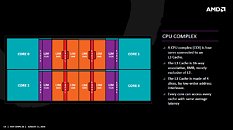Tuesday, August 23rd 2016

AMD ZEN Quad-Core Subunit Named CPU-Complex (CCX)
We've been chasing AMD Zen for a long time now. Our older report from April 2015 uncovered an important detail about component organization on Zen processors - the clumping of four CPU cores into a highly-specialized, possibly indivisible subunit referred to then, as the "Zen Quad-core Unit." Some of the latest presentations about the architecture, following AMD's "performance reveal" event from earlier this month, shed more light on this quad-core unit.
AMD is referring to the Zen quad-core unit as the CPU-Complex (CCX). Each CCX is a combination of four independent CPU cores. Unlike on "Bulldozer," a "Zen" core does not share any of its number-crunching machinery with neighboring cores. Each "Zen" core has a dedicated L2 cache of 512 KB, and four Zen cores share an 8 MB L3 cache. AMD will control core-counts by controlling CCX units. A "Summit Ridge" socket AM4 processor features two CCX units (making up eight cores in all), sharing a dual-channel DDR4 memory controller, and the platform core-logic (chipset), complete with an integrated PCI-Express root complex. Socket AM4 APUs will feature one CCX unit, and an integrated GPU in place of the second CCX. With this, AMD is able to bring the two diverse desktop platforms under one socket.
Source:
Heise.de
AMD is referring to the Zen quad-core unit as the CPU-Complex (CCX). Each CCX is a combination of four independent CPU cores. Unlike on "Bulldozer," a "Zen" core does not share any of its number-crunching machinery with neighboring cores. Each "Zen" core has a dedicated L2 cache of 512 KB, and four Zen cores share an 8 MB L3 cache. AMD will control core-counts by controlling CCX units. A "Summit Ridge" socket AM4 processor features two CCX units (making up eight cores in all), sharing a dual-channel DDR4 memory controller, and the platform core-logic (chipset), complete with an integrated PCI-Express root complex. Socket AM4 APUs will feature one CCX unit, and an integrated GPU in place of the second CCX. With this, AMD is able to bring the two diverse desktop platforms under one socket.

44 Comments on AMD ZEN Quad-Core Subunit Named CPU-Complex (CCX)
so CCX basically same as '4 cores per module' thingy?
OR
its like GPC Block-Nvidia style?
beside for most office PC, dual cores is sufficient
Don't make and brag about bloody APU's if you don't plan on supporting it like all of your products AMD...
"
1 CCX= 2cores
edit 1 CCX= 4 coressee above^
Also Zen has SMT (a la HyperThreading). So dual-core chips with SMT are possible. I doubt AMD will make dual-core parts based on "Summit Ridge" silicon, though. Maybe the APU silicon which has just one CCX.1 CCX = 4 cores. Summit Ridge has 2 CCX or 8 cores.
Isn't that like saying that the GTX 970 can access every memory with same average bandwidth? But leaving jokes aside, do they say if a CCX can access the L3 cache of another CCX? If not, I don't see how they can build a true 8 core CPU, but instead a 2P 4 core system with horrible cache latency issues.
I dont understand why there wasnt more outcry over that. AMD completely dropped drivers for actively sold GPUS for an entire new OS. They couldnt have made one more driver to at least let these old devices work rightSo, your laptop cant handle the heat from a 15 watt dual core part, and you are blaming the dual core on your poor performance? Thats ridiculous.
Our work machines are optiplex 780s, with core 2 duos, and such slowdowns are not observed. Even with multiple programs+office+chrome+IE, these systems run fine (the magic of 8GB of RAM and a SSD). Skylake desktop i3s offer more power then any office user needs. Mobile dual core chips from intel run rings around our core 2s.
Perhaps you should invest in a laptop cooling pad, or a less junky laptop.
I'm gonna use my psychic powers to predict that your laptop's issue is too little RAM or a spinning hard disk, not the CPU.
You forgot the demanding browsers too...